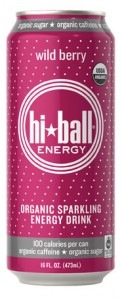They might have been doing well, but some of the best-performing young beverage brands on the market have recently enacted significant changes. From packaging formats to brand identity, these companies altered their approaches and cite the risks they took as key catalysts to growth. Below are examples of these rebranded companies that shared their stories with BevNET.com at Natural Products Expo West.
From Glass to Can
A few years removed from selling energy drinks out of the trunk of his car, Todd Berardi, president and founder of HiBall Energy, was enjoying his brand’s 30 percent growth per year. He hadn’t reached profitability, but the good-enough numbers kept the business afloat.
When he launched the brand in August 2005, Berardi sold HiBall in 10 oz. glass bottles. With most of the category in cans, Berardi saw the upscale packaging as his point of differentiation — but it was also becoming his weak link. While growth remained steady, margins were shrinking and eventual profitability seemed unfathomable.
While Berardi envisioned HiBall as a pioneer in glass, feedback from demonstrations and sampling sparked another direction. Regardless of some entrepreneur’s vision, consumers associate energy drinks with cans, Berardi said. To find proper shelf placement and to catch the eye of the quick-thinking shopper, he had to make the switch. The 30 percent growth might have validated his concept, but the current packaging wasn’t maximizing the brand’s potential. Of course, that potential didn’t make the actual change any easier.
“I couldn’t really sleep at night,” Berardi said.

“It was a very difficult decision, because we basically started the company over after five and a half years of hard work,” he said of the packaging switch.
In May 2012, Berardi switched to 16 oz. cans. Growth has since ballooned to 146 percent. Now, with such rapid growth, Berardi has realized that the liquid, not the packaging, is the point of differentiation.
Differentiation by the Bottle
At times, a packaging change can be as drastic as switching from glass to can, like HiBall. In other circumstances, simply escaping the standards of packaging can lead to significant growth.
When Ben Weiss, founder, CEO and chairman of bai, launched his brand in August 2009, he sold his products in 16.9 oz. Amcor PowerFlex bottles. The bottles worked fine, Weiss said, and served as an affordable and effective option for startups — but he knew that the packaging was temporary. The goal of every startup? To emerge from the vast sea of other startups.
“Having your own bottle helps you bust through,” Weiss said.

The change in packaging didn’t simply improve margins and separate bai from its competition; it implied a psychological difference. This beverage, which boasts unique taste and health benefits, is packaged in its own bottle because it aims to be its own drink, Weiss said. Run-of-the-mill brands aiming to stuff pockets and run fast may prefer standard bottles for the rest of their existences. More than his unique formula, Weiss demands comprehensive differentiation, which led to the proprietary bottle.
And the switch has paid off. Sales have increased tenfold since the change to a proprietary bottle, Weiss said. After January and February, bai had exceeded company sales expectations by 17 percent. As of Expo West, bai projects more than $25 million in sales for 2013.
“The product really stands tall on the shelves,” he said.
Clean Identity
Some of the better packaging adjustments often comply with identity. Martin Chalk, co-founder of Balance Water, felt that his brand previously overwhelmed consumers. He might have been selling a stress-relieving, flavorless water, but the packaging was too crowded to project that.
“It looked more like a dietary supplement than it did a refreshing beverage,” Chalk said.

Thus, Balance’s bottles are designed with tactile Aborigine symbols, such as a flower at the center of a water hole. The symbols have a bumpy texture that Chalk said consumers like to touch. This contributes to what he believes is an eye-catching appearance.
“That’s helpful in a very crowded space such as water,” he said.
Chalk said that the new label reflects the brand’s simplicity and pays homage to the Aboriginals. It has also caught on in New York City, Balance’s biggest market, where it can be found in 600 to 700 locations (Duane Reade, Food Emporium, etc.) and 5,000 retail outlets across the northeast. Chalk said that the brand is growing by 20 to 30 percent each month.
HiBall, bai, and Balance Water have all experienced recent growth, and the packaging should be considered as no more than a cog in each brand’s extensive business model. However the packaging also shouldn’t be forgotten. Whether it’s fitting into a specific channel, rising from the standard or clarifying an identity, proper packaging can save a brand from destruction, and perhaps lead it to previously unknown heights.